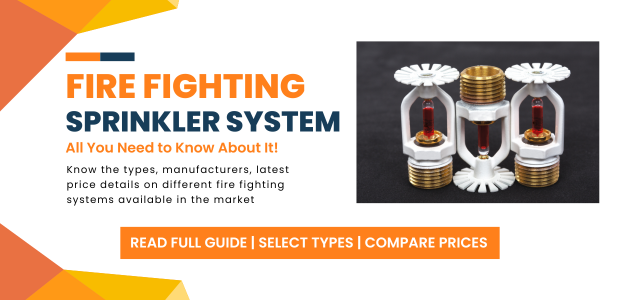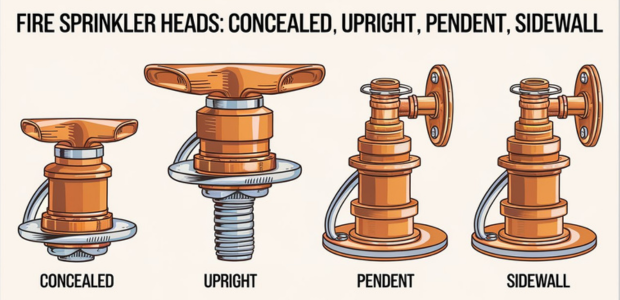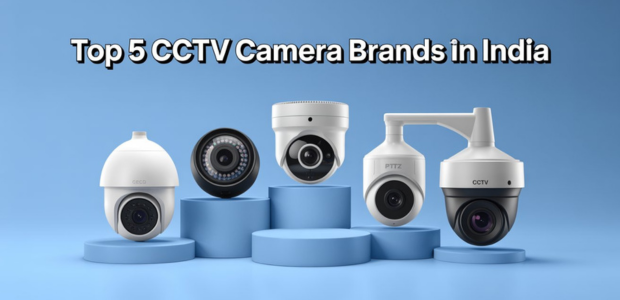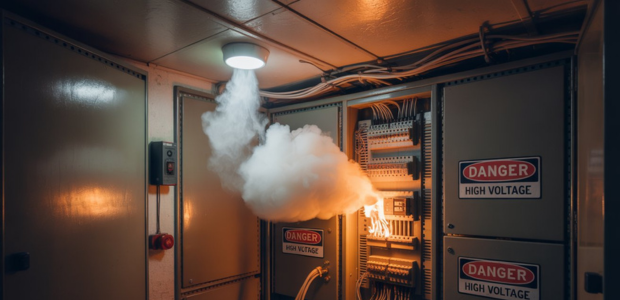All About Fire Fighting Sprinkler System: Types, Latest Price

- May 16, 2025
- Interface Digital
Fire safety is one of the most crucial aspects of any building or infrastructure. Whether it’s a residential apartment, commercial complex, or industrial facility, a Fire Fighting Sprinkler System acts as the first line of defense in the event of a fire outbreak. But how exactly do these systems work? What are the different types? And most importantly, how much do they cost? In this comprehensive blog, we break it all down for you.
How Does a Fire Sprinkler System Work?
- Sprinklers are connected by a network of pipes that is usually hidden beneath walls and ceilings. An early-stage fire's high temperature (135° to 165°F) will activate the sprinkler.
- Only intense heat causes the sprinkler to flow water. Only the sprinkler nearest to the fire will activate, directing water directly onto the flames in the region of the fire's origin. This prompt response controls or puts out the flames (often, even the fire brigade arrives).
- According to the National Fire Protection Association, a typical residential fire sprinkler produces 13 to 15 gallons of water per minute. At high pressure, however, a fire hose's typical flow ranges from 95 to 200 gallons per minute.
- Obviously, when you are activating a fire sprinkler, it will result in significantly less water damage.
Key Components of Fire Sprinkler System
1. Sprinkler Heads
- A fire sprinkler head is a heat sensor with a liquid-filled glass bulb that emits water to kill flames when a fire warms the air. It includes a heat-sensitive component, a sealing system, a deflector, and a nozzle.
- There are several types of fire sprinkler heads, some of which sense heat automatically and others that require manual activation. Dry pipe sprinkler systems are used in cold climates to keep pipes from freezing.
2. Piping System
This network transports water from the supply to the sprinkler heads. Subject to the system type, these pipes can be filled with water (wet systems) or pressured air (dry systems).3. Control Valves
Sprinkler systems use control valves to control the flow of water. Closing the valve stops the flow of water to the fire sprinklers.4. Alarm Valves
These detect when water flows through the system due to a sprinkler activation and then trigger alarms to notify residents and emergency services.5. Fire Pump
A fire pump and a jockey pump connected to the sprinkler system operate together to rectify small fire sprinkler pressure differences. The fire pump ensures water is delivered with the needed pressure to all parts of the system.6. Water Supply Source
This can be a municipal water connection, a dedicated reservoir, or a combination of sources. A consistent and reliable water supply is vital for the efficiency of a Fire Fighting Sprinkler System.Also read: Fire Suppression vs Fire Sprinkler: Key Differences You Must Know
Fire Sprinkler Types
1. Dry Pipe Sprinkler System
- Dry pipe systems are comparable to wet pipe systems, however, they do not always include water. Instead, water is retained behind a valve, which allows air to escape from the open sprinkler head. This results in a pressure decrease, which allows the valve to open and water to flow.
- This method is great for unrestricted spaces or high-temperature locations to prevent freezing, but it needs hot enough temperatures in the area where the water enters and the valve is installed.
2. Wet Pipe Sprinkler System
- Wet pipe sprinkler systems are widely employed because they are dependable and cost-effective.They entail continually filling the sprinkler pipe with water and enabling water to flow out of a certain head when the ceiling temperature reaches a predetermined point.
- Yet, not all sprinkler heads will run at the same time. To avoid freezing water, the place to be protected should be kept at or above 40°F (4°C). If the temperature cannot be assured, another system type should be selected.
3. Fire Hydrant Sprinkler
A fire hydrant is a link that carries water from a central position to the right area to control and decrease fire. The supply of water is managed by a regulator.4. Pendent Sprinkler
- A pendent fire sprinkler hangs from pipes and disperses water in a domed or conical shape. It is visible after installation and available in a variety of diameters, K-factors, orifice sizes, and spray patterns.
- Pendent fire sprinklers come in a number of models from major suppliers, such as:
- Viking's VK3021 and VK1021
- Tyco's TY323
- Victaulic's V2708 FireLock
- Senju's ZN-QR flush sprinklers
- However, variances in safety certifications, design, and manufacturing processes might make a sprinkler more appropriate for certain situations.
5. Sidewall Sprinkler
- Sidewall fire sprinklers are placed alongside walls or beneath beams to protect tiny rooms, closets, and corridors. They employ a semicircular deflector to create a crescent-shaped spray pattern. Horizontal sidewall sprinklers can only be put underneath smooth, flat, horizontal ceilings, according to NFPA standards.
- They're widely used in hotels, restaurants, churches, and organizations. The typical paints for manufacturers' horizontal sidewall sprinklers include:
- White
- Black
- Brass
- Chrome
- Manufacturers provide slightly different versions, which might make installation easier and improve product life.
6. Automatic Sprinkler System
Automatic Sprinklers have several smaller pipes and small holes that release water in the event of a fire.7. Commercial Sprinkler Systems
A commercial sprinkler system is a network of pipes filled with water or fire suppressant used to control or extinguish fires in buildings. It identifies a fire and releases water to extinguish it, saving lives and property while giving firemen additional time to arrive and take control.8. Upright Sprinkler
- Upright fire sprinklers direct water upward to a concave deflector, resulting in a dome-shaped pattern that covers particular regions and prevents ice and debris from gathering. They often appear in warehouses, industrial areas, and refurbished open-ceiling constructions.
- The most appropriate sprinklers have a 3/4" thread connector and an 8.0 K-factor, despite smaller ones have a 5.6K orifice.
- While vertical fire sprinklers are a popular option across fire sprinkler manufacturers, not all are the same.
9. Ceiling Sprinkler
Ceiling sprinkler is built into the ceiling, offering a more aesthetically pleasing appearance while still ensuring effective coverage.10. Bushfire Sprinkler System
A bushfire sprinkler system is an external water spray system that shields homes and surrounding regions from bushfires. These sprinklers soak the building's exterior and surroundings, forming a water barrier that extinguishes embers and prevents fire spread.Which is the Best Fire Fighting System for Building?
- When choosing the fire fighting system for building, a wet pipe sprinkler system is the best choice.
- The reason?
- It is because it can be paired with a reliable fire pump and a dedicated water reservoir. It ensures quick activation and consistent water pressure. Integrating alarm valves and smoke detectors enhances early detection and response.
Also read: The Best Fire Alarm System to Install in Buildings | Interface Digital
Looking for the best fire sprinkler system for an office?
- Considering a fire sprinkler system for office? Pendent or sidewall sprinklers are the best choice. Pendent or sidewall sprinklers are very effective if they are connected to a wet pipe system.
- Automatic sprinkler systems ensure that the workplace remains protected even after hours. The design should ensure minimal water damage to office electronics and documents.
Fire Fighting Sprinkler System - Compare Latest Prices
Pricing for a Fire Fighting Sprinkler System varies based on the building size, system type, and components used. Below is an approximate guide:| Types of Sprinkler System in Fire Fighting | Fire Sprinkler System Cost (Rs) |
| Wet Pipe System | 170-595 per head |
| Dry Pipe System | 5,500 |
| Fire Pump (including installation) | 85,000-4,15,000 |
| Control Valves | 180 per piece |
| Piping | 150-3,000 |
Note: Prices vary significantly by region, supplier, and complexity of installation.
What are the NFPA guidelines?
The NFPA provides a comprehensive set of standards and codes to ensure fire safety in buildings. Key NFPA standards related to sprinkler systems include:- NFPA 13: Installation of Sprinkler Systems
- NFPA 25: Inspection, Testing, and Maintenance
- NFPA 20: Installation of Stationary Pumps
Maintenance Tips - Dos & Don'ts of Fire Safety
- DOs:
- Schedule regular inspections (quarterly and annually).
- Always check for leaks, corrosion, and blockages.
- Test alarm systems and control valves.
- Replace damaged sprinkler heads immediately.
- DON'Ts:
- Don’t paint over sprinkler heads.
- Don’t block sprinkler coverage with furniture or any decor items.
- Don’t skip professional maintenance inspections.
Facing Maintenance Issues? Here's How to Solve It!
1) Sprinkler Head Leaking?
Check for damage or corrosion. Replace the head and ensure it’s properly sealed.2) Fire Pump Not Working?
Ensure power supply is stable. Test manually to verify operation. Check for motor or panel faults.3) Blockage in Fire Sprinkler Heads?
Dust, paint, or debris can block heads. Clean regularly and avoid painting near them.4) Corroded Sprinkler Heads?
Caused by moisture or poor air quality. Replace with corrosion-resistant models and install air dryers if needed.5) Frozen Pipes?
It is very common in dry systems. Ensure insulation and consider heat tracing.6) Low Water Pressure?
Check water supply, pump performance, and pipe integrity. Pressure gauges should be tested regularly.7) Microbiologically Influenced Corrosion?
It is caused by microbial growth. Regular chemical treatments and pipe flushing can prevent buildup.8) Not Receiving Notifications?
Inspect alarm systems, control panels, and backup batteries. Ensure software is updated and integrated with monitoring services.Interface Digital - Hassle-Free Installation & Maintenance Services
- Looking for a smooth experience?
- Interface Digital offers comprehensive Fire Fighting Sprinkler System solutions, including installation and maintenance. We have been providing these services since 1995.
- We provide sprinkler systems services in India and the UAE.
- Products that we install are eco-friendly, customizable, respond to fire early, and are available 24/7. They include:
- Beam detectors
- Smoke detectors
- Heat detectors
- Fire sensors
- Fire alarm control panel
- Fire alarm monitoring
- Fire alarm inspection
- Fire alarm maintenance
- Fire alarm notification
- Fire Hydrant
- IOT Rack Suppression
- Novec Cylinder
FAQs
Q1. What is a suppression system?
A suppression system refers to any engineering collection of devices designed to extinguish fires.Q2. How many types of fire suppression systems are there?
There are over types of fire suppression systems, are water-based, foam-based, chemical-based, and gas-based systems.Q3. What are key components of a fire fighting system?
Fire alarm systems, fire detection and notification systems, suppression agents and systems, and automatic sprinkler systems are key components of the fire fighting system.Q4. What is a bushfire sprinkler system?
A bushfire sprinkler system is an external water spray system that shields homes and surrounding regions from bushfires.Q5. What is the most common type of fire?
The most common sort of fire is a Class A fire, which contains basic flammable materials such as wood, paper, fabric, rubber, and plastic.Conclusion
- Fire safety isn't choice; it's required. A properly constructed and maintained fire fighting sprinkler system can make what separates a minor incident and a huge calamity.
- From identifying system types to guaranteeing regular maintenance, this guide will provide you with everything you need to safeguard people and property.
- Choose the appropriate system, adhere to the NFPA requirements, and do not be afraid to seek expert assistance with installation and maintenance.
Also read: Understanding the Different Types of Fire Detectors








